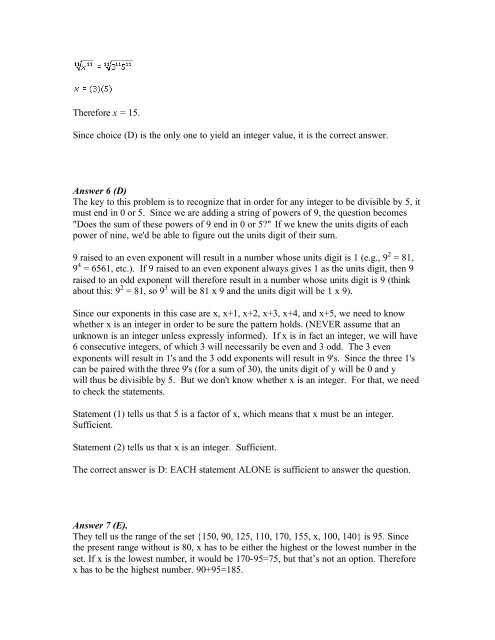GMAT-Math
Create successful ePaper yourself
Turn your PDF publications into a flip-book with our unique Google optimized e-Paper software.
Therefore x = 15.<br />
Since choice (D) is the only one to yield an integer value, it is the correct answer.<br />
Answer 6 (D)<br />
The key to this problem is to recognize that in order for any integer to be divisible by 5, it<br />
must end in 0 or 5. Since we are adding a string of powers of 9, the question becomes<br />
"Does the sum of these powers of 9 end in 0 or 5?" If we knew the units digits of each<br />
power of nine, we'd be able to figure out the units digit of their sum.<br />
9 raised to an even exponent will result in a number whose units digit is 1 (e.g., 9 2 = 81,<br />
9 4 = 6561, etc.). If 9 raised to an even exponent always gives 1 as the units digit, then 9<br />
raised to an odd exponent will therefore result in a number whose units digit is 9 (think<br />
about this: 9 2 = 81, so 9 3 will be 81 x 9 and the units digit will be 1 x 9).<br />
Since our exponents in this case are x, x+1, x+2, x+3, x+4, and x+5, we need to know<br />
whether x is an integer in order to be sure the pattern holds. (NEVER assume that an<br />
unknown is an integer unless expressly informed). If x is in fact an integer, we will have<br />
6 consecutive integers, of which 3 will necessarily be even and 3 odd. The 3 even<br />
exponents will result in 1's and the 3 odd exponents will result in 9's. Since the three 1's<br />
can be paired with the three 9's (for a sum of 30), the units digit of y will be 0 and y<br />
will thus be divisible by 5. But we don't know whether x is an integer. For that, we need<br />
to check the statements.<br />
Statement (1) tells us that 5 is a factor of x, which means that x must be an integer.<br />
Sufficient.<br />
Statement (2) tells us that x is an integer. Sufficient.<br />
The correct answer is D: EACH statement ALONE is sufficient to answer the question.<br />
Answer 7 (E).<br />
They tell us the range of the set {150, 90, 125, 110, 170, 155, x, 100, 140} is 95. Since<br />
the present range without is 80, x has to be either the highest or the lowest number in the<br />
set. If x is the lowest number, it would be 170-95=75, but that’s not an option. Therefore<br />
x has to be the highest number. 90+95=185.


